Best Food to Eat in Peru [ Local traditional ] 2025
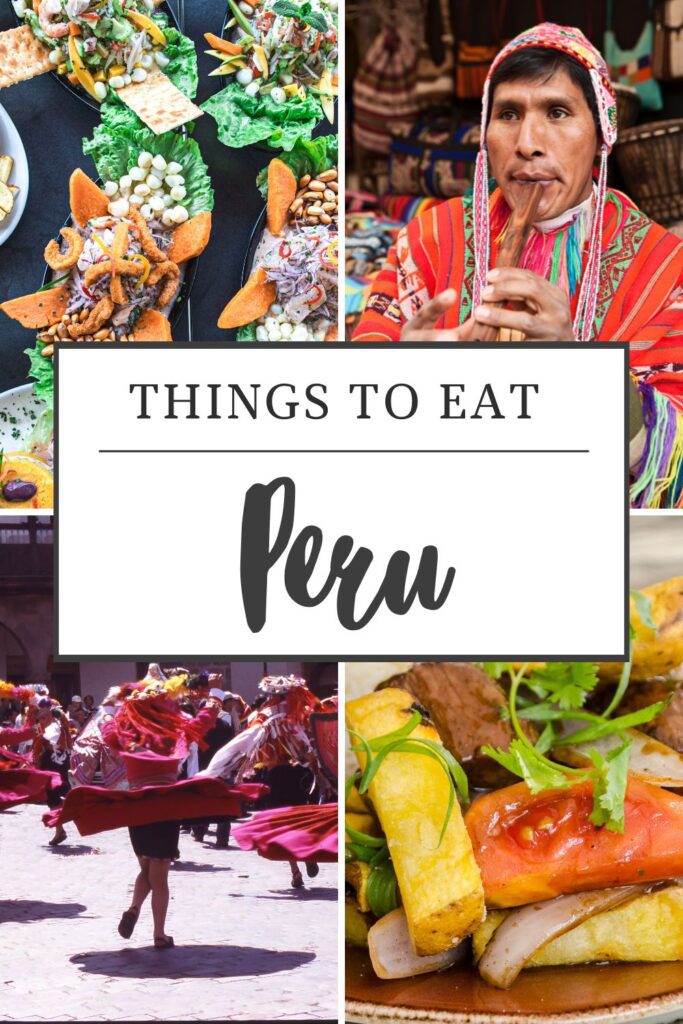
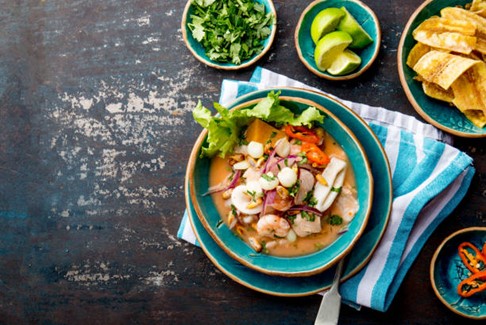
The first time I went to Peru, I was really surprised with the quality of the food . The basic “Almuerzo” ( Popular lunch very cheap ) is very classic ( Potatoes and arroz con pollo ) but I discovered many others delights such as ceviche ( peru’s national dish), sweet potatoes ( there is hundreds of types ), and they love their pork belly or pork rinds. In the local market near you, you will find yummy food and the street vendors have many different original dishes!
Don’t forget to try the pisco sour ( local alcohol ) as this is a full part of discovering Peruvian culture.
TABLE OF CONTENTS :
- 10 must have food in Peru
- 10 locals fruits available in Peru
- Best time to visit Peru to enjoy it’s local food
- Best places to explore local foods of Peru
- Best dishes enjoyed by local peoples of Peru
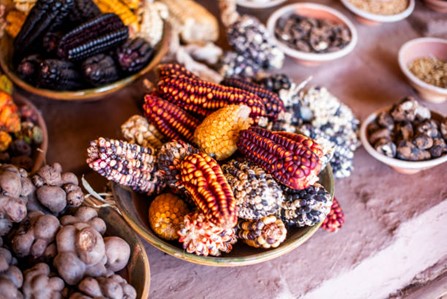
Best Food to Eat in Peru
Peru, a land of enchantment nestled in the heart of South America, beckons travelers with its rich tapestry of history, culture, and natural wonders. From the mystical peaks of the Andes to the dense jungles of the Amazon, Peru’s diverse landscapes offer a captivating journey through time and terrain.
At its core lies the awe-inspiring legacy of ancient civilizations, most notably the Inca Empire, whose architectural marvels, such as the iconic Machu Picchu, stand as testaments to human ingenuity and perseverance.
Beyond its archaeological treasures, Peru boasts a vibrant cultural tapestry woven from a blend of indigenous traditions and Spanish colonial influences. Bustling markets, adorned with vibrant textiles and artisan crafts, invite exploration, while traditional festivals and culinary delights tantalize the senses.
Whether trekking along ancient Inca trails, cruising through the mystical depths of the Amazon River, or immersing oneself in the vibrant rhythm of Andean music and dance, Peru offers a kaleidoscope of experiences sure to leave a lasting impression on any traveler daring enough to venture into its embrace.
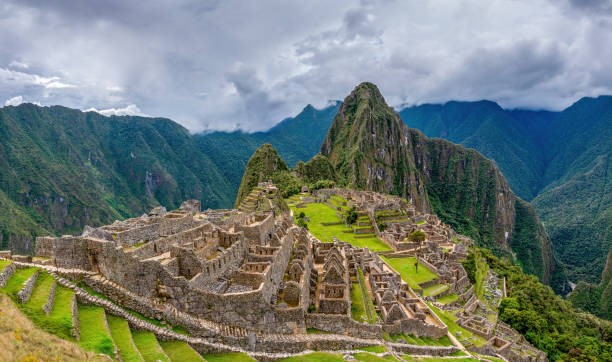
10 Must Have Foods in Peru
Peruvian cuisine is a rich tapestry woven from a diverse array of ingredients and culinary traditions, reflecting the country’s multicultural heritage and varied landscapes. Here are ten must-have foods that showcase the unique flavors and ingredients of Peru:
1. Ceviche:
This iconic dish is a cornerstone of Peruvian cuisine, featuring fresh seafood marinated in citrus juices, typically lime or lemon, and spiced with chili peppers and onions. The acidity of the marinade “cooks” the seafood, resulting in a refreshing and flavorful appetizer or main course. Variations abound, with different regions of Peru adding their own twists, such as using different types of fish or adding unique ingredients like sweet potato or corn.
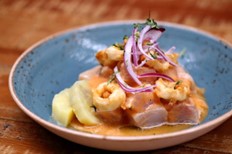
2. Lomo Saltado:
A beloved Peruvian-Chinese fusion dish, lomo saltado combines stir-fried beef, onions, tomatoes, and peppers with soy sauce and vinegar, served over a bed of rice. The marriage of savory beef with tangy and aromatic flavors creates a satisfying and hearty dish that reflects Peru’s cultural diversity and culinary innovation.
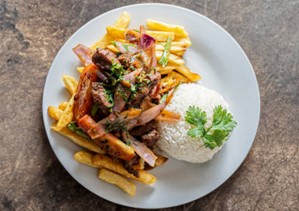
3. Aji de Gallina:
This creamy and mildly spicy chicken stew is a comforting classic in Peruvian households. Shredded chicken is cooked in a sauce made from Aji Amarillo peppers, onions, garlic, and evaporated milk, then served over boiled potatoes and garnished with hard-boiled eggs and olives. Aji de Gallina offers a delightful balance of flavors and textures, making it a favorite comfort food.
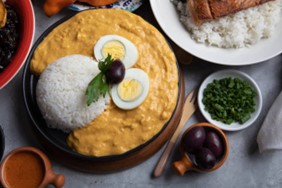
4. Anticuchos:
Originating from Peru’s Afro-Peruvian community, Anticuchos are skewers of marinated and grilled beef heart, typically served with boiled potatoes and a spicy chili sauce known as Aji Panca. Tender and flavorful, Anticuchos are a popular street food enjoyed across Peru, offering a unique taste of the country’s culinary heritage.
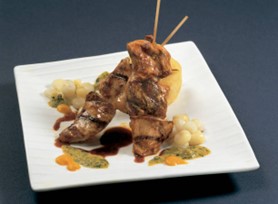
5. Papa a la Huancaina:
This quintessential Peruvian appetizer features boiled potatoes smothered in a creamy sauce made from aji amarillo peppers, cheese, milk, and crackers, garnished with hard-boiled eggs and olives. Papa a La Huancaina showcases Peru’s love for potatoes and its talent for transforming simple ingredients into vibrant and delicious dishes.
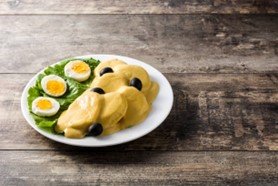
6. Causa:
Another potato-based delight, Causa is a layered dish made from mashed potatoes seasoned with lime juice and aji amarillo, filled with various fillings such as tuna, chicken, or avocado, and garnished with mayonnaise, hard-boiled eggs, and olives. Its colorful presentation and harmonious blend of flavors make Causa a popular choice for parties and celebrations.
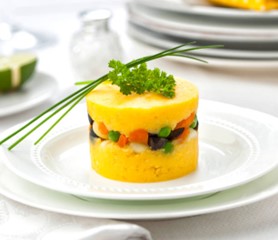
7. Rocoto Relleno:
Hailing from the Arequipa region, Rocoto Relleno is a spicy and hearty dish that features rocoto peppers stuffed with a mixture of ground beef, onions, garlic, and spices, topped with melted cheese and baked to perfection. Despite its fiery reputation, Rocoto Relleno is a favorite among adventurous eaters seeking bold and robust flavors.
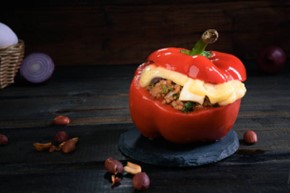
8. Cuy (Guinea Pig):
Considered a delicacy in the Andean regions of Peru, Cuy has been a staple protein source since ancient times. Typically roasted whole and served with potatoes and Aji sauce, Cuy offers a unique culinary experience, with tender and flavorful meat that is often compared to rabbit or chicken.
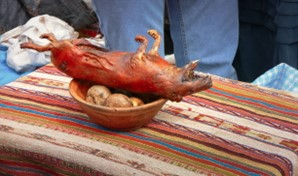
9. Chifa:
As a testament to Peru’s cultural diversity, Chifa refers to Peruvian-Chinese cuisine, which blends traditional Peruvian ingredients and cooking techniques with Chinese flavors and ingredients. Popular dishes include Chaufa (fried rice), Tallarin Saltado (stir-fried noodles), and Arroz Chaufa (fried rice with Chinese sausage), offering a fusion of flavors that tantalize the taste buds.
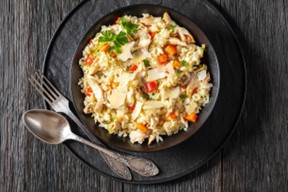
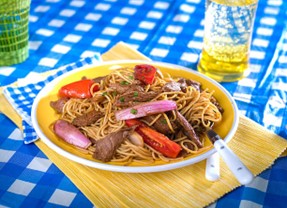
10. Alfajores:
These delicate sandwich cookies consist of two shortbread-like cookies filled with Dulce de Leche (caramelized milk) and dusted with powdered sugar. Alfajores are a beloved treat in Peru, enjoyed as an indulgent dessert or sweet snack, showcasing the country’s penchant for creating decadent and irresistible sweets.

From the coastal delights of ceviche to the highland flavors of Rocoto Relleno and the multicultural influences of Chifa, Peru’s cuisine is a testament to its rich history, diverse landscapes, and vibrant culinary traditions. Exploring these must-have foods offers a tantalizing journey through Peru’s gastronomic landscape, where every bite tells a story of tradition, innovation, and cultural exchange.
10 Local Fruits Available in Peru
Peru is blessed with a diverse array of fruits, thanks to its varied climates and ecosystems. From the lush Amazon rainforest to the high Andean mountains, each region of Peru boasts its own unique fruits, many of which are cherished for their exotic flavors and nutritional benefits. Here are ten local fruits of Peru:
1. Lucuma:
Known as the “Gold of the Incas,” lucuma is a beloved Peruvian fruit prized for its sweet, custard-like flesh. Native to the Andean valleys, lucuma is often used in desserts such as ice cream, pudding, and cakes, imparting a unique flavor reminiscent of sweet potato and caramel

2. Chirimoya:
Also known as custard apple, Chirimoya is a tropical fruit native to the Andean region of Peru. Its creamy, white flesh has a delicate flavor that combines notes of pineapple, banana, and vanilla. Chirimoya is typically enjoyed fresh or blended into smoothies and desserts.
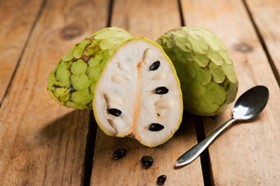
3. Aguaymanto:
Commonly known as goldenberry or cape gooseberry, Aguaymanto is a small, golden fruit encased in a papery husk. Tart and slightly sweet, Aguaymanto is often eaten raw or used to make jams, sauces, and desserts, adding a bright and zesty flavor to dishes.

4. Maracuya:
Also known as passion fruit, Maracuya is a tropical fruit with a tangy and aromatic flavor. Its juicy pulp is often used to make refreshing juices, cocktails, and desserts, or simply eaten fresh with a spoon. Maracuya’s unique flavor adds a tropical twist to any dish or beverage.

5. Granadilla:
Similar in appearance to passion fruit, Granadilla is another popular fruit in Peru known for its sweet and fragrant pulp. Encased in a hard, orange shell, granadilla’s translucent seeds are surrounded by a jelly-like flesh that is enjoyed fresh or used to make desserts and beverages.
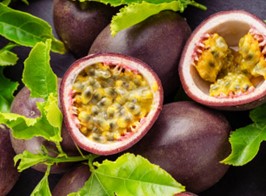
6. Camu Camu:
This small, sour berry grows in the flooded forests of the Amazon basin and is prized for its exceptionally high vitamin C content. Camu camu is often used to make juices, jams, and supplements, offering a tart and tangy flavor that packs a nutritional punch.
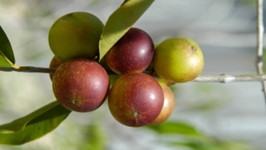
7. Pitahaya (Dragon Fruit):
With its vibrant pink or yellow skin and speckled flesh, pitahaya is a visually stunning fruit native to Peru. Mildly sweet and refreshing, pitahaya is enjoyed fresh or used to make smoothies, salads, and desserts, adding a tropical flair to any dish.
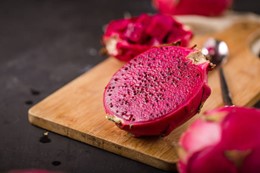
8. Sacha Inchi:
Also known as the Inca peanut or mountain peanut, sacha inchi is a small, nutty fruit native to the Amazon rainforest. Rich in omega-3 fatty acids and protein, sacha inchi seeds are often roasted and eaten as a nutritious snack or pressed to produce oil for cooking and skincare.
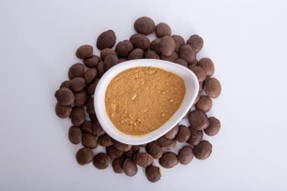
9. Tumbo:
Tumbo, or banana passionfruit, is a tropical fruit with a unique flavor that combines the sweetness of bananas with the tanginess of passionfruit. Its juicy pulp is commonly used to make refreshing beverages, jams, and desserts, adding a tropical twist to culinary creations.
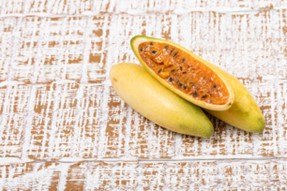
10. Pepino:
Pepino, or pepino dulce, is a sweet and juicy fruit native to the Andes mountains. Resembling a cross between a melon and a cucumber, pepino has a refreshing flavor reminiscent of honeydew with hints of citrus. It is often enjoyed fresh or used to make salads and fruit bowls.

These ten local fruits of Peru showcase the country’s rich biodiversity and culinary heritage, offering a tantalizing array of flavors, textures, and nutritional benefits. Whether enjoyed fresh, blended into beverages, or incorporated into desserts and savory dishes, Peru’s fruits are sure to delight the senses and provide a taste of the country’s vibrant culture and natural abundance.
Best time to visit Peru to enjoy its local food
Determining the best time to visit Peru to enjoy its local food involves considering factors like seasonal produce availability, weather conditions, and cultural festivals. Here’s a breakdown of the ideal times to savor Peru’s culinary delights:
1. Spring (September to November):
- Springtime in Peru brings mild temperatures and clear skies, making it an excellent time to explore outdoor markets and sample fresh fruits and vegetables.
- Many fruits, such as mangoes, avocados, and citrus fruits, are in season during spring, offering an abundance of ingredients for refreshing juices, salads, and ceviches.
- Spring also coincides with the beginning of the Peruvian culinary festival season, with events like Mistura in Lima showcasing the country’s diverse cuisine through food tastings, cooking demonstrations, and cultural performances.
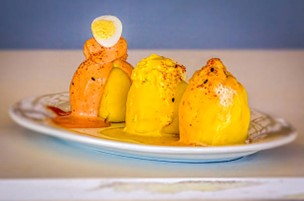
2. Summer (December to February):
- Summer in Peru is characterized by warm weather and longer daylight hours, creating the perfect conditions for outdoor dining and street food experiences.
- During this time, coastal regions like Lima and northern Peru offer an abundance of fresh seafood, including ceviche, tiradito, and seafood stews, as fishing is at its peak.
- Additionally, tropical fruits like mangoes, passion fruit, and pineapple are readily available during summer, adding vibrant flavors to dishes and beverages.
3. Fall (March to May):
- Fall marks the end of the rainy season in many parts of Peru, making it an ideal time to explore the country’s diverse landscapes and culinary traditions.
- In the highland regions, fall brings the harvest season for staples like potatoes, corn, and quinoa, which are used in traditional Andean dishes like Pachamanca and Choclo con Queso.
- Fall is also a great time to visit the Amazon rainforest, where you can discover unique ingredients like exotic fruits, nuts, and herbs used in indigenous cuisine.
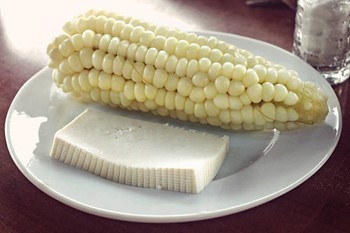
4. Winter (June to August):
- Despite being Peru’s winter season, this time of year is still conducive to culinary exploration, especially in the highland regions where the weather remains mild and dry.
- Winter is the season for Peruvian comfort foods like Lomo Saltado, Aji de Gallina, and Rocoto Relleno, which provide warmth and sustenance on cooler days.
- Additionally, winter coincides with traditional Andean festivals such as Inti Raymi (Festival of the Sun), where you can experience local cuisine served alongside cultural performances and rituals.
5. Year-round:
- While certain fruits and vegetables may have specific seasons, many ingredients essential to Peruvian cuisine are available year-round, ensuring a diverse culinary experience regardless of the time of year.
- Coastal cities like Lima offer a wide range of seafood dishes year-round, thanks to the abundance of marine life along Peru’s Pacific coast.
- Additionally, Peruvian staples like potatoes, corn, beans, and rice are available year-round and form the foundation of many traditional dishes served throughout the country.
Ultimately, the best time to visit Peru to enjoy its local food depends on personal preferences and interests. Whether you’re seeking seasonal delicacies, cultural festivals, or simply want to explore Peru’s diverse culinary landscape, there’s something to satisfy every palate year-round.
Best places to explore local foods of Peru
Exploring Peru’s culinary scene is an adventure in itself, with diverse flavors and regional specialties waiting to be discovered. Here are some of the best places to enjoy local food in Peru:
1. Lima:
✔️ Central Market (Mercado Central):
Dive into the heart of Lima’s food culture at Mercado Central, where bustling stalls offer a vibrant array of fresh produce, seafood, meats, and local delicacies. Sample ceviche, tiradito, and seafood dishes prepared on the spot by expert chefs.
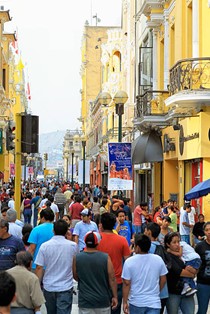
✔️ Miraflores District:
This upscale neighborhood is home to a plethora of restaurants and eateries serving traditional Peruvian cuisine with a modern twist. From cozy cevicherias to trendy fusion restaurants, Miraflores offers a diverse dining experience for every taste.
Check our Miraflores guide HERE
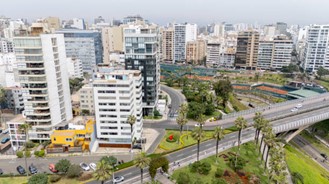
✔️ Barranco District:
Known for its bohemian charm, Barranco is a culinary hotspot with a mix of traditional eateries, artisanal markets, and trendy cafes. Explore the neighborhood’s narrow streets and discover hidden gems serving authentic Peruvian dishes in a relaxed atmosphere.
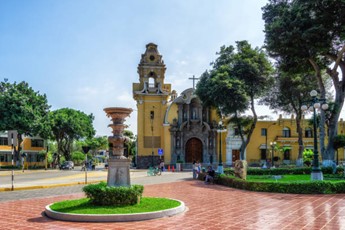
2. Cusco:
✔️ San Pedro Market (Mercado San Pedro):
Immerse yourself in the sights, sounds, and aromas of Andean cuisine at Cusco’s largest market. Sample local specialties like Cuy (guinea pig), alpaca meat, quinoa soup, and empanadas, while browsing stalls selling fresh fruits, cheeses, and spices.
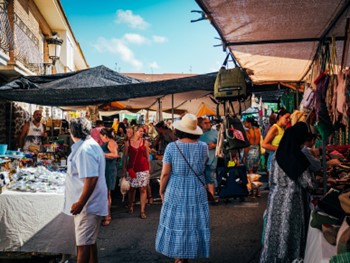

✔️ Plaza de Armas:
Surrounding Cusco’s main square are numerous restaurants and cafes offering traditional Peruvian fare with a view. Enjoy a leisurely meal while taking in the historic ambiance of the city center, accompanied by live music and street performances.
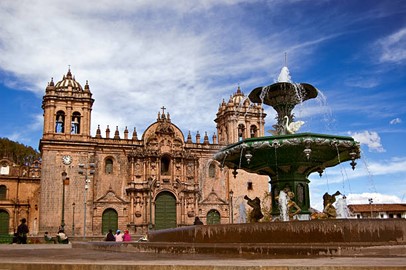
✔️ Chicherias: Experience the ancient Andean tradition of chicha, a fermented corn beverage, at one of Cusco’s Chicherias. These local watering holes serve chicha alongside hearty snacks like roasted corn, potatoes, and grilled meats, providing a taste of authentic Andean hospitality.

3. Arequipa:
- ✔️ San Camilo Market (Mercado San Camilo): Wander through Arequipa’s oldest and largest market and sample regional specialties like rocoto relleno, adobo, and chupe de camarones. Don’t miss the opportunity to try local fruits, cheeses, and desserts like Queso Helado (frozen cheese dessert).
- ✔️ Zona Monumental: Explore Arequipa’s historic center, a UNESCO World Heritage Site, and discover quaint cafes, traditional picanterias, and upscale restaurants serving Arequipa’s unique blend of Andean and Spanish cuisine.
- ✔️ Yanahuara District: Enjoy panoramic views of the city and nearby volcanoes while dining at one of Yanahuara’s scenic restaurants. Savor Arequipa’s signature dishes, such as rocoto relleno and ocopa, while admiring the colonial architecture and lush gardens of this charming neighborhood.
4. Iquitos:
- ✔️ Belén Market (Mercado de Belén): Navigate the floating market of Belén, where vendors sell fresh fish, fruits, and exotic ingredients from the Amazon rainforest. Sample local delicacies like juanes (rice and meat wrapped in banana leaves) and tacacho con cecina (mashed plantains with smoked pork).
- ✔️ Malecón Tarapacá: Along the banks of the Itaya River, you’ll find a variety of restaurants and food stalls offering Amazonian cuisine with a view. Feast on grilled fish, fried plantains, and exotic fruits while soaking in the vibrant atmosphere of Iquitos’ waterfront.
- ✔️ Pacaya Samiria National Reserve: For a truly immersive culinary experience, embark on a gastronomic tour of the Amazon rainforest. Local guides will introduce you to indigenous ingredients and cooking techniques, allowing you to sample wild fruits, freshwater fish, and medicinal plants
- prepared by local communities.
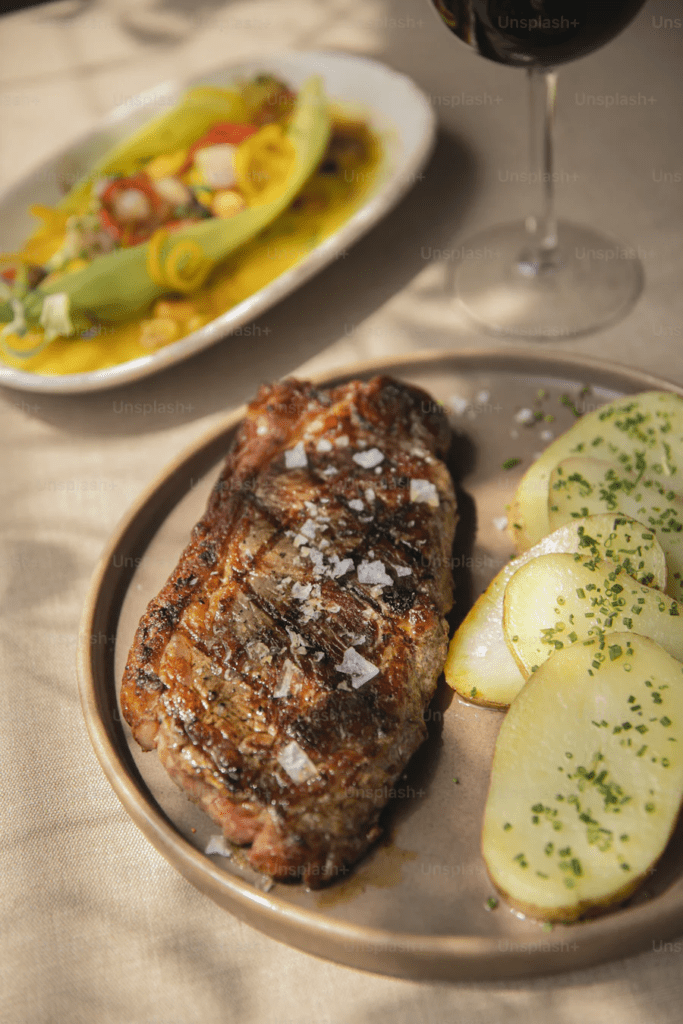
5. Nazca:
- Nazca Market (Mercado de Nazca): Explore the bustling market of Nazca and sample regional specialties like Tamales, Anticuchos, and Carapulcra. Don’t miss the opportunity to try fresh figs, guavas, and lucuma, as well as Nazca’s famous Alfajores (filled cookies).
- Plaza de Armas: Surrounding Nazca’s central square are numerous cafes and restaurants serving traditional Peruvian dishes with a local twist. Enjoy alfresco dining while admiring views of the Nasca Lines and soaking in the laid-back ambiance of this historic town.
- Pisco Vineyards: Venture into the surrounding valleys and visit local pisco vineyards to sample Peru’s national spirit. Learn about the production process and enjoy tastings of pisco and pisco-based cocktails, accompanied by traditional Peruvian snacks.
Each of these destinations offers a unique culinary experience, showcasing the flavors and traditions of Peru’s diverse regions. Whether you’re exploring the bustling markets of Lima, savoring Andean delicacies in Cusco, or indulging in Amazonian cuisine in Iquitos, you’re sure to discover a world of culinary delights waiting to be savored.

⚠️ Don’t forget our complete guides about Peru
✅Things to do in Miraflores Lima , Peru
✅Best time to visit Machu Picchu, Peru
✅Best Ayahuasca retreats in Peru
☝🏻 And way more
🔍 Just type ” Peru “ or the topic you choose in the search bar for all our articles
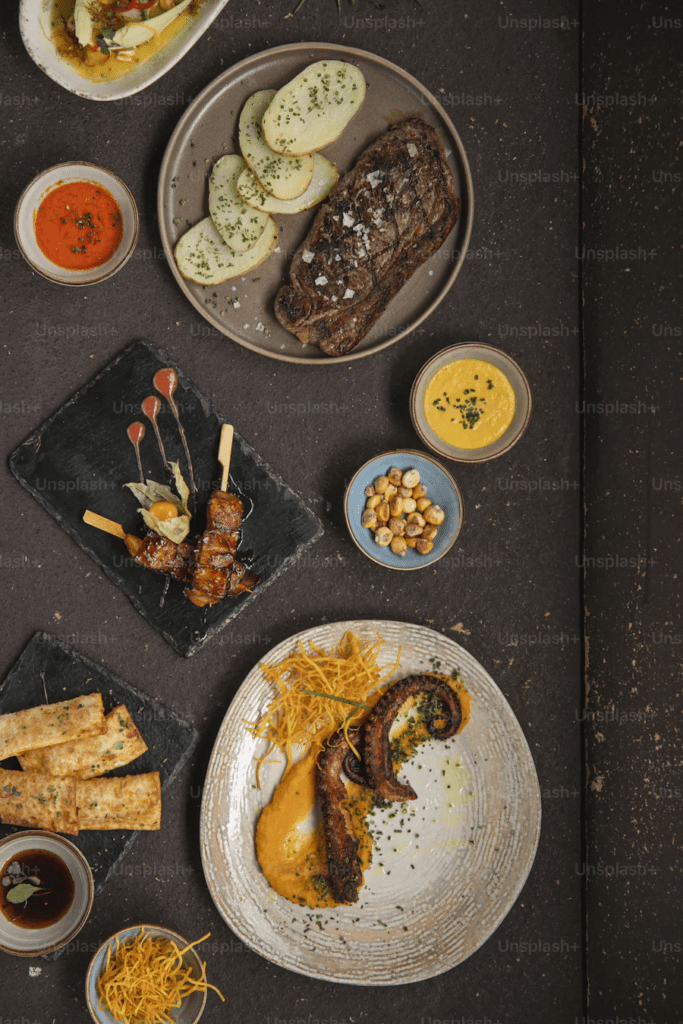
Best dishes enjoyed by local people of Peru
Peruvian cuisine is renowned for its rich flavors, diverse ingredients, and unique culinary traditions. Here are some of the best dishes enjoyed by local people across Peru:
1. Ceviche:
- A national favorite, ceviche is a refreshing dish made from fresh raw fish marinated in citrus juices, typically lime or lemon, and seasoned with onions, chili peppers, and cilantro.
- Variations include mixed seafood ceviche (ceviche mixto) and fish ceviche served with sweet potato, corn, and lettuce. It’s often enjoyed as a light lunch or appetizer, especially along the coast.
2. Lomo Saltado:
- This popular Peruvian-Chinese fusion dish features stir-fried beef marinated in soy sauce and vinegar, tossed with onions, tomatoes, and peppers, and served over a bed of rice.
- Lomo saltado is known for its bold flavors and hearty portions, making it a favorite comfort food among Peruvians.
3. Aji de Gallina:
- Aji de gallina is a creamy chicken stew made with aji amarillo peppers, onions, garlic, and evaporated milk. Shredded chicken is cooked in the flavorful sauce and served over boiled potatoes, garnished with hard-boiled eggs and olives.
- This comforting dish is often enjoyed for lunch or dinner, especially during family gatherings and celebrations.
4. Anticuchos:
- Anticuchos are skewers of marinated and grilled beef heart, typically served with boiled potatoes and a spicy chili sauce known as aji panca.
- This street food favorite is a staple of Peruvian cuisine, offering a savory and satisfying snack or meal enjoyed by locals and visitors alike.
5. Papa a la Huancaina:
- Papa a la huancaina features boiled potatoes smothered in a creamy sauce made from aji amarillo peppers, cheese, milk, and crackers, garnished with hard-boiled eggs and olives.
- This classic Peruvian appetizer showcases the country’s love for potatoes and its talent for creating flavorful sauces.
6. Causa:
- Causa is a layered dish made from mashed potatoes seasoned with lime juice and aji amarillo, filled with various fillings such as tuna, chicken, or avocado, and garnished with mayonnaise, hard-boiled eggs, and olives.
- Its colorful presentation and harmonious blend of flavors make causa a popular choice for parties and special occasions.
7. Rocoto Relleno:
- Rocoto relleno is a spicy and hearty dish featuring rocoto peppers stuffed with a mixture of ground beef, onions, garlic, and spices, topped with melted cheese and baked to perfection.
- Despite its fiery reputation, rocoto relleno is a beloved comfort food in Peru, offering a satisfying combination of flavors and textures.
8. Chicha Morada:
- Chicha morada is a refreshing beverage made from purple corn, pineapple, cinnamon, cloves, and lime juice. The mixture is boiled and then sweetened with sugar before being served chilled.
- This non-alcoholic drink is enjoyed throughout Peru, especially during celebrations and festivals.
9. Pollo a la Brasa:
- Pollo a la brasa is a rotisserie-style chicken marinated in a blend of spices, including cumin, paprika, and garlic, then roasted until golden and juicy.
- Served with french fries and a side of salad or rice, pollo a la brasa is a favorite dish for family dinners and casual gatherings.
10. Alfajores:
- Alfajores are delicate sandwich cookies filled with dulce de leche (caramelized milk) and dusted with powdered sugar.
- These sweet treats are enjoyed as a dessert or snack, often accompanied by coffee or tea, and are a popular indulgence among Peruvians of all ages.
These dishes represent just a glimpse of the culinary richness of Peru, where traditional flavors blend seamlessly with international influences to create a vibrant and diverse gastronomic landscape enjoyed by locals and visitors alike. Whether sampling street food in Lima or indulging in a home-cooked meal in the Andes, exploring Peruvian cuisine is a delicious adventure waiting to be savored.
Wrapping up
Peruvian cuisine is a vibrant tapestry woven from a rich blend of indigenous traditions, colonial influences, and diverse ecosystems. From the coastal regions of Lima to the high Andean mountains and the lush Amazon rainforest, Peru’s culinary landscape reflects the country’s cultural heritage and natural bounty. At the heart of Peruvian cuisine is a reverence for fresh, locally sourced ingredients, showcased in dishes that range from comforting stews to elegant ceviches and intricate desserts.The diversity of Peru’s geography and climate has given rise to a vast array of flavors and ingredients, each region contributing its own specialties and culinary techniques. Along the coast, seafood reigns supreme, with ceviche, tiradito, and seafood stews highlighting the bounty of the Pacific Ocean.
In the Andean highlands, hearty staples like potatoes, corn, and quinoa form the basis of traditional dishes like pachamanca and aji de gallina. Meanwhile, the Amazon rainforest offers an abundance of exotic fruits, nuts, and game meats, providing a unique culinary experience rooted in indigenous traditions.Peruvian cuisine is not only a reflection of the country’s past but also a dynamic expression of its present and future. As Peru continues to evolve and embrace global influences, its culinary scene remains a source of pride and innovation, attracting food enthusiasts from around the world. Whether savoring street food in bustling markets or dining in upscale restaurants, exploring Peruvian cuisine is a journey of discovery, where each bite tells a story of tradition, creativity, and the enduring spirit of a nation.

⚠️ Don’t forget our complete guides about many countries in the world ( 5 continents )
✅ What to do cities by cities
✅ Trekking, Yoga, adventure, surf and the best activities
✅ Best food and best cafés
☝🏻 And way more about the world
🔍 Just type the topic / country you choose in the search bar for all our articles
WHO AM I ?
Hello !
I am Eric, a French Australian citizen based between Australia, Asia and Bali an I love to travel and experience the world. I generally like outdoor activities, wellness, great food and venues , party and real local adventures ! I am a Yoga practitioner and fitness lover
I created this blog because I love to travel and I want to share my experiences with others. I’ve been traveling since I was a child, and I’ve been to over 50 countries. I’ve seen some amazing things and met some amazing people, and I want to help others experience the same things.
I believe that travel is one of the best ways to learn about the world and about yourself. When you travel, you’re forced to step outside of your comfort zone and experience new things. You learn about different cultures, different religions, and different ways of life. You also learn about yourself, your strengths, and your weaknesses.
Travel can also be a great way to make new friends. When you’re traveling, you’re surrounded by people from all over the world, and you’re all in the same boat. You’re all there to explore and experience new things, and that can create a bond between people.

Uyuni Salar, Boliva
Let’s connect together !
I hope that my travel blog will inspire others to travel and to see the world. I also hope that it will help people to learn about different cultures and to become more open-minded.

Taj Mahal, Agra, India



![Top Things to Do in Colombia [Ultimate List 2025]](https://funkyfreshtravels.com/wp-content/uploads/2024/06/Picture2-3.jpg)
![Best Time to Visit Machu Picchu [Pro Guide 2025]](https://funkyfreshtravels.com/wp-content/uploads/2024/06/Picture1-5.jpg)
![The Best Restaurants in Medellin for Great Food [2025 Foodie Guide]](https://funkyfreshtravels.com/wp-content/uploads/2024/06/Picture1-1.jpg)
![Best Ayahusaca Retreats Peru for Healing [ SAFE ] 2025](https://funkyfreshtravels.com/wp-content/uploads/2024/06/Picture1-11.jpg)
![The Best Restaurants in Cali [Foodie Choice 2025]](https://funkyfreshtravels.com/wp-content/uploads/2024/06/Picture1.jpg)